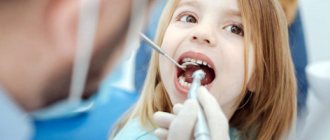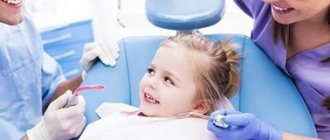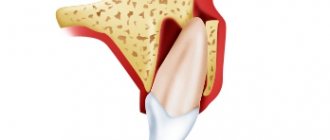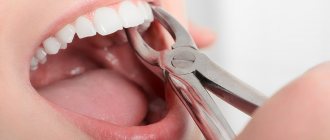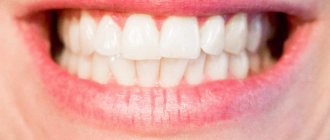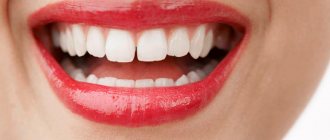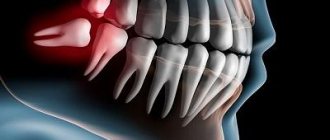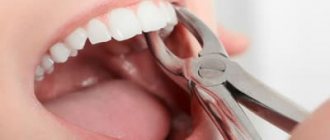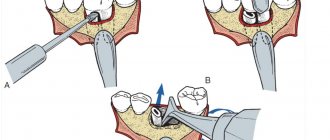Milk teeth are bone formations that are designed for mechanical processing of food in order to prepare it for subsequent digestion. They also influence diction and make the child’s speech correct and clear. In terms of their anatomical structure, they are in many ways similar to permanent ones, but they all have some differences. Among them:
- the coronal part is smaller;
- the thickness of enamel and dentin is less (from 0.6 to 1 mm);
- reduced degree of mineralization;
- no immune zones;
- the pulp volume is large;
- dental canals are shorter;
- poorly developed tubercles in the closure zone.
As for the number of root canals, their number remains unchanged.
The roots of baby teeth are slightly inclined. This is explained by the fact that the rudiments of permanent units are located above them.
It is a mistake to believe that children's teeth do not have roots. But this is what many adults think when they look at their children’s fallen teeth. In fact, by the time of prolapse, the formations located in the alveoli are almost completely resolved.
Home methods for removing baby teeth are not always safe
The most common way to forcibly pull out loose baby teeth at home is with a thread tied to the tooth and wound around the door handle. Some “lucky” readers probably went through this procedure in childhood and remember how unpleasant it was. Home methods for pulling teeth are not always safe. Such removal can provoke the development of infection or inflammation of the socket of the extracted tooth, which requires serious treatment. Find out what to do if the hole becomes rotten after tooth extraction.
Using improvised means, you can remove a baby tooth at home only if it is literally “hanging by a thread.” But in order not to cause psychological trauma to the child, this procedure must be made into a game.
How to protect baby teeth from caries?
Prevention is the best way to cope with any disease. Therefore, those parents who care about the health of their children should definitely think about caries prevention. How to protect baby teeth from caries? The recommendations of experts in this matter are as follows:
- The correct diet for the mother during pregnancy is with a sufficient amount of foods containing calcium, fluorine and phosphorus: cottage cheese, beef and beef liver, sea fish, nuts, fruits and vegetables, cereal porridges.
- Compliance with hygiene standards: daily brushing from the moment the first teeth appear, first with a cotton or gauze swab with boiled water, then with special baby brushes and pastes. Plaque on baby teeth should be removed promptly and thoroughly.
- A healthy diet for a child: as little fast carbohydrates, carbonated drinks, sweets as possible, more fruits and vegetables, cereals, and dairy products.
- Timely visits to the dentist for preventive examinations (at least once every six months).
It is important that parents develop a conscious attitude towards the health of their children's teeth and oral cavity in general. A timely visit to the dentist in case of any identified problems, as well as for regular medical examinations, will help maintain the health of the child’s dental system – and therefore the digestive system too.
Little Mouse VS Tooth Fairy
Loss of baby teeth in children is associated with rituals in different countries. In Russia, back in ancient times (since the 18th century), there was a belief that a lost tooth should be put in the hole of a mouse and in return ask it for a permanent one, which will be healthy and durable.
In the West, instead of a mouse, the Tooth Fairy is popular, which exchanges a baby tooth placed under the pillow for money. This is precisely the reason why children in Russia nowadays prefer to “cooperate” with her.
How do the roots of baby teeth dissolve?
The process of replacing children’s teeth with “adult” ones normally occurs at the age of 5-7 years. It is during this period of life that a person first becomes partially toothless. But before the first incisor falls out, serious physiological changes will occur in the structure of its roots. We are talking about the process of resorption, better known under the term “resorption”. Let's look at how this happens.
First, the hard plate that separates the germ of a permanent tooth and the roots of a milk tooth begins to collapse. Small pits with osteoclasts form inside the roots. The roots located near the bud are the first to disappear. The process always starts from the apex and moves towards the gum.
Soon, the loose fibrous connective tissue located inside the crown is replaced by granulation tissue. The latter is also important for timely resorption. After this, very little time passes before the tooth begins to become very loose and one day falls out. A permanent unit is soon shown in the vacated space.
In most cases, resorption proceeds in balance with the eruption of permanent teeth, but sometimes failures occur. Then the roots of children's baby teeth are preserved for a long time or, conversely, are destroyed much earlier than expected. Such phenomena are undesirable.
Forced resorption occurs due to traumatic injuries, tumor growths, strong pressure from “neighbors,” deep bite, and orthodontic disorders. A slowdown in the process is possible if there are no rudiments at all.
Thus, children have roots of baby teeth. They are simply subject to resorption. That is why they cannot be seen by the time they fall out.
In the future, people will not have wisdom teeth
It is now recognized that wisdom teeth are vestigial. This is the most problematic group of teeth, with many painful moments associated with it. When they erupt, a person may experience severe pain, inflammation, fever, and when all wisdom teeth appear, crowding of the dentition may begin. At the same time, they play almost no role in the process of experiencing food. Evolutionary changes lead to the fact that in modern times, wisdom teeth are increasingly not erupting in adults. It can be assumed that in the future they will disappear altogether.
Why is it important to treat baby teeth?
Now that it is clear that the structure of baby teeth is very similar to permanent teeth, the question “To treat them or not to treat them” should not arise for parents at all. Advanced caries often leads to destruction and damage to the pulp. Then the roots become involved in the pathological process. Removing dental nerves is not a pleasant procedure. It is important to prevent its occurrence.
Moreover, refusal of dental treatment can result in a number of other problems. This means:
- Incorrect bite formation. If, due to the destruction of the crown, the doctor has to remove it ahead of time, voids appear in the row, which “neighbors” tend to occupy. Then, by the time the “adult” unit erupts, there may not be a place for it - it will begin to grow somewhere on the side and ruin the smile.
- Damage to future teeth even before they erupt. With deep caries and periodontitis, cysts often form. They affect the rudiments of permanent teeth. Then the child is faced with the fact that his new tooth turns out to be sick and requires urgent treatment. Needless to say, its service life will be significantly reduced because of this.
- Diseases of the gastrointestinal tract. If parents believe that it is better to remove baby teeth rather than treat them, then by the age of nine their child (especially if he is prone to developing dental diseases) may lose half of his teeth. Is it possible to fully chew food in such a situation? No. The child regularly swallows poorly chewed foods. Because of this, the load on the intestines increases, which can result in frequent abdominal pain, stool disorders, nausea, gastritis and more serious gastrointestinal diseases.
- Psychological complexes. At 9-10 years old, a child evaluates his appearance and sees that his smile is very different from the smiles of his peers - it does not have a large number of teeth or they are dark in color, half destroyed. Because of this, he begins to be embarrassed to smile, laugh, and tries to talk less. All this negatively affects his self-esteem and does not allow him to quickly adapt to new situations and successfully go through the process of socialization in elementary school.
Don't waste your children's teeth. Teach your child from childhood to undergo preventive examinations in the pediatric dentistry department. At the same time, choose a specialist for him who you can trust. Then the child will not perceive another visit to the dentist as something terrible. He will be happy to go to the appointment, knowing that he will not be hurt.
What to do after a child’s tooth extraction?
- Make sure that the child spits out the tampon that was placed after removal after 15-20 minutes.
- After removal, a blood clot should remain in the hole, which protects it from inflammation. There is no need to clean the hole from blood, rinse the mouth, the child should not touch the removal site with hands or objects.
- If the child has been given anesthesia, explain to the child that he should not bite on the numb side until the feeling of cold and pins and needles goes away.
- Feed your baby only warm, soft food for several days.
- Maintain good hygiene; brushing your teeth is not only possible, but also necessary, with a soft toothbrush, carefully avoiding the extraction site.
- If the tooth extraction was difficult, then try to limit the child’s physical activity so as not to provoke bleeding.
Treat caries or remove a tooth?
Here, the recommendations of pediatric dentists agree: teeth need to be treated, although this is often associated with inconvenience. True, it is now much easier to persuade a child to calmly undergo treatment than it was before, when quality dentistry was unavailable. In a modern clinic, a calm and friendly atmosphere is important in a pediatric dentist's office. The doctor will first show the instruments, explain what he will do, and establish contact with the child. And drugs for pain relief will help carry out the treatment so that there are no negative impressions left from it.
Dental treatment is not scary! Especially if it doesn't hurt
It is best to treat tooth decay in its early stages. Then you can do without drilling at all - it will be enough to clean the surface of the tooth and apply a remineralizing composition. Small areas of caries can also be treated using a special device that uses a laser beam.
But even if a large carious cavity has already formed in the tooth, it is still recommended to install a filling. In some cases, crowns are even placed to save the tooth, which will last until the tooth falls out naturally. All this is justified in order to preserve the functionality of the tooth, which is extremely important for the formation of a correct permanent bite in a child.
Crowns can be installed to save teeth
Are there nerves in baby teeth?
The structure of baby teeth is similar to the structure of permanent teeth:
- The outside of the tooth is covered with one of the hardest tissues of the body - enamel. The tooth is additionally covered with a cuticle - a membrane that wears off when chewing food;
- There is bone tissue under the tooth. It is the basis of the tooth and is located around the root of the tooth;
- the canal and crown are filled with pulp, in which numerous capillaries and nerve endings are intertwined. Milk and molar teeth begin to form in the child, who is still in the womb of the mother. Medical research has proven that these teeth already have roots and nerves.
By the time a child’s first teeth begin to erupt, their roots have already dissolved. Milk teeth are destroyed under the influence of acids found in food, pathogenic microorganisms and mechanical damage. A child's first teeth are covered with a thinner layer of enamel, so they hurt, just like adults.
If your tooth starts to hurt, don’t delay your visit to the pediatric dentist. Inflammation may begin, which will affect the gum tissue, and tooth treatment will be more painful.
When should a baby tooth not be removed?
There are situations when it is IMPOSSIBLE to remove a baby tooth, so as not to aggravate the child’s condition or provoke serious complications.
- If a child suffers from an acute infectious disease, then removal should be postponed until complete recovery.
- If there is an acute inflammatory process in the oral cavity - stomatitis, gingivitis, candidiasis (thrush), then removal is carried out after the acute stage of the disease subsides.
- If the tooth is located in the area of any tumor, removal is carried out together with the tumor and in the hospital.
- Teeth removal is carried out with caution in small patients suffering from diseases of the central nervous system, heart, kidneys, and blood.
Everything has its time
One of the most frequently asked questions to our doctors from mothers is: “In what order do teeth begin to fall out?”
It usually starts at the age of 5 years. The very first teeth that undergo this process are the incisors, then the fourth and fifth teeth of the row, then the canines. To make it more clear to you, here is a diagram of the loss and eruption of baby teeth:
Don't worry if your child is over 5 years old and his teeth aren't starting to change. Each child’s body is individual, and much depends on nutrition, dental care, daily routine, and climatic conditions. In girls, the loss of baby teeth begins a little earlier than in boys. If you are still worried, then contact your dentist and conduct an unscheduled examination.
I would also like to note the timing. Complete replacement of milk teeth with molars occurs within 6-7 years. There is no need to specifically tear them out or loosen them. Everything will happen naturally.
The doctor prescribes removal only if the baby tooth has not yet fallen out, but the root tooth is already beginning to grow.
What anesthesia is used to remove baby teeth in children?
If we are talking about removing a baby tooth that is already loose, without complications and signs of inflammation, then such removal does not require pain relief.
If a problematic baby tooth is removed or it sits firmly in the jaw, then local anesthesia is used for children, sometimes with sedation.
Tooth extraction under anesthesia (general anesthesia) is possible in special clinics where a team of anesthesiologists works. From a medical point of view, in most cases there is no need to remove baby teeth under anesthesia. This is usually due to the fear of the child and his parents. The use of anesthesia is justified only in cases of serious mental disorders or complex illnesses, because it has more dangers than benefits .
Anatomy of different types of temporary teeth
- Incisors.
- Fangs.
- Molars.
Eight temporary incisors have the same structure - a fairly flat crown and 1 root. The incisors of the upper dentition, like the rest of the teeth, are larger than the lower ones. In the center, the incisors have one canal, and in 93% of cases, the lateral ones have two.
The four temporary canines are distinguished by a slightly sharp crown on all sides and the longest root. The crown of the canine preceding the permanent one is shorter and convex. The root has a rounded shape in cross-section and a slightly curved apex towards the buccal direction.
Each of the eight teeth of this type has a multi-cusped chewing surface and ends in several root canals. These are the largest teeth in childhood. The second molars are always larger than the first, which cannot be said about similar molars.
Is it possible to remove a baby tooth at home?
The human body is programmed to independently change teeth without complications. If the child does not have dental or general diseases, then the natural loss of a baby tooth is the most desirable scenario. You don't need to do anything to do this. Just when a child’s tooth is loose, pay extra attention to hygiene, because brushing a child’s loose teeth on their own is painful. Make sure that the child does not touch the tooth with his hands - it can cause an infection.
How to help a baby tooth fall out on its own?
The simplest and most effective way is to give your child something hard to chew on, such as an apple. It is better to refuse threads and other fancy devices.
If you decide to help the process a little and remove the interfering tooth yourself, clamp it with a sterile napkin, try to turn it a little around its axis and remove it. Do not “twist” the tooth with force or put pressure on it, so as not to damage the bone and soft tissue. After removal, have your child bite on a sterile cotton swab for 10-15 minutes. There is no need to rinse your mouth after removal; do not feed your child solid food or hot foods for several days.
If you suspect that the tooth has not been completely removed, or the child complains that there is a sharp edge in the hole that “scratches” - contact your dentist as soon as possible.
How to go to the dentist, remove a baby tooth and not scare your baby?
It is recommended that a child’s baby teeth be removed by pediatric dentists: it will be painless, safe and timely. For everything to go smoothly, a visit to the dentist should be associated with something pleasant and calm. Modern dentistry has a friendly atmosphere, new painkillers have appeared, and instruments (especially in children's offices) do not inspire fear.
Finally, our advice: don’t worry and don’t let your child worry. The calmer you are about going to the dentist, the calmer your baby will behave. Stay nearby in the dentist's office, because parental support is extremely important to him.
How temporary teeth are removed
Like any other medical procedure, tooth extraction has a clearly developed scheme and is carried out in several stages:
- Local anesthesia is the most common form of anesthesia. Specialists turn to more serious methods (general anesthesia) only in extreme cases: pathologies of the child’s psyche, purulent processes in the oral cavity, an allergic reaction and a history of individual intolerance to local anesthetics;
- Application of forceps to the crown;
- Rocking baby tooth;
- Its removal from the hole;
- Removal of fragments and granulations remaining in the socket;
- Packing the wound surface.
In order for both the doctor and the little patient to feel comfortable, parents must prepare the child and explain to him the importance of this procedure. Mental preparation is an important aspect of treatment.
